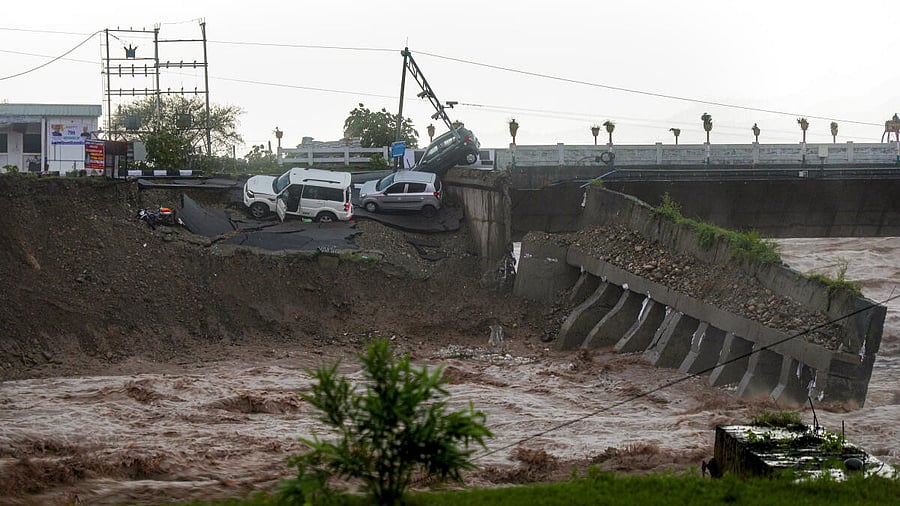
Vehicles stuck as a portion of the Fourth Tawi Bridge damaged after relentless rainfall, at Bhagwati Nagar, in Jammu, Tuesday, Aug. 26, 2025.
Credit: PTI Photo
Srinagar: At least 32 pilgrims lost their lives in a massive landslide that struck the revered Mata Vaishno Devi shrine route in Jammu’s Katra area, officials said on Wednesday, as rescuers continued to pull bodies out from the debris a day after the tragedy.
The calamity occurred on Tuesday afternoon when a mountainside gave way near Inderprastha Bhojnalaya at Adhkwari, about halfway along the 12-km winding trek from Katra to the shrine. Around 3 pm, boulders and stones came crashing down the slope, catching hundreds of pilgrims off guard.
According to officials, 30 bodies were recovered from the debris while two critically injured pilgrims succumbed at a hospital later. Several others remain under treatment.
“Rescue teams are still combing through the rubble amid fears that more people could be trapped underneath. The operation is challenging due to unstable terrain,” a senior official overseeing the operation said.
The pilgrimage to the hilltop shrine, one of the most visited religious destinations in northern India, was immediately suspended after the disaster. The route has been sealed for safety checks as fresh slides are feared.
Officials said the yatra would only resume after a thorough assessment of the route’s safety. With rains showing no signs of abating and rivers running high, the region continues to remain on edge.
Monsoon havoc spreads across Jammu
The landslide tragedy comes barely two weeks after a cloudburst unleashed flash floods in Chisoti, the last motorable village on the route to the Machail Mata shrine in Kishtwar district, killing at least 65 people — mostly pilgrims — and leaving more than 100 injured. Thirty-two people remain missing from that incident, with rescue teams still searching in the rugged mountainous terrain.
Just four days later, on August 17, another cloudburst wreaked havoc in Jod Ghati village of Kathua district. At least seven people, including four children, lost their lives, while several others sustained injuries.
Together, the tragedies underscore the vulnerability of Jammu and Kashmir’s pilgrimage routes and hill settlements to extreme weather events that have intensified during the ongoing monsoon.
Across the Jammu region, officials said, critical infrastructure has suffered heavy damage. Several bridges have collapsed, electricity poles and mobile towers have crumbled, and many villages remain cut off. The situation has left thousands stranded in remote areas.
Relief and rescue efforts
Lieutenant Governor Manoj Sinha said over 5,000 people have been evacuated from flood-hit low-lying areas of Jammu region over the past 48 hours.
Joint teams of the Army, National Disaster Response Force (NDRF), State Disaster Response Force (SDRF), J&K Police, and local authorities are engaged in round-the-clock rescue operations. Helicopters have been kept on standby, while engineers are working to restore road connectivity to cut-off villages.
Local volunteers have also joined the efforts, helping carry stranded families, elderly residents, and children to safer ground. In Katra, residents formed human chains to guide pilgrims to shelter during the initial chaos after the landslide.
Flood threat in Kashmir valley
Meanwhile, the flood threat has reached critical levels in Kashmir valley, where the Jhelum River breached the danger mark of 22 feet at Sangam in Anantnag district on Wednesday morning. Authorities sounded a flood alert as heavy rainfall continued in south and central Kashmir, raising fears of a repeat of the devastating 2014 floods.
“People living along the embankments have been advised to move to safer locations. Emergency teams are on alert,” an Irrigation and Flood Control Department official said.
Several low-lying areas in Srinagar and Pulwama reported waterlogging, forcing residents to shift household belongings to upper floors.
Recurring climate disasters
Experts point out that the region’s fragile Himalayan terrain, coupled with unplanned construction and deforestation, has made it increasingly vulnerable to extreme weather events. Narrow valleys, steep slopes, and loose mountain soil mean even moderate rainfall can trigger landslides or flash floods.
“The frequency and intensity of cloudbursts and landslides in Jammu and Kashmir have increased sharply in the past decade. The disasters at Vaishno Devi and Machail Mata shrine routes are grim reminders of the risks,” said a disaster management expert at Jammu University.